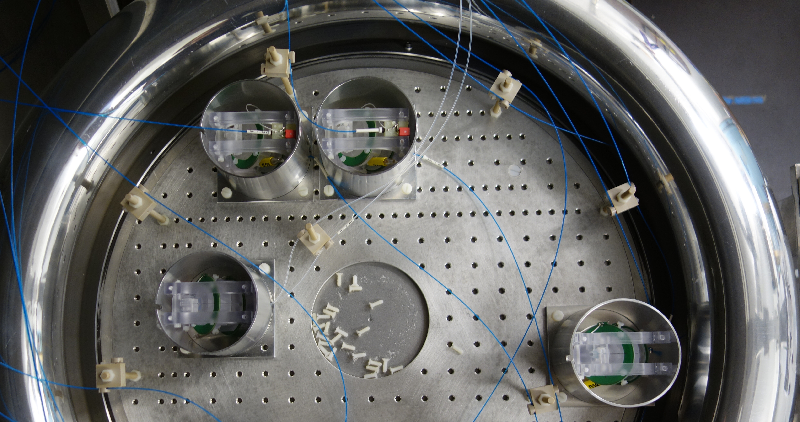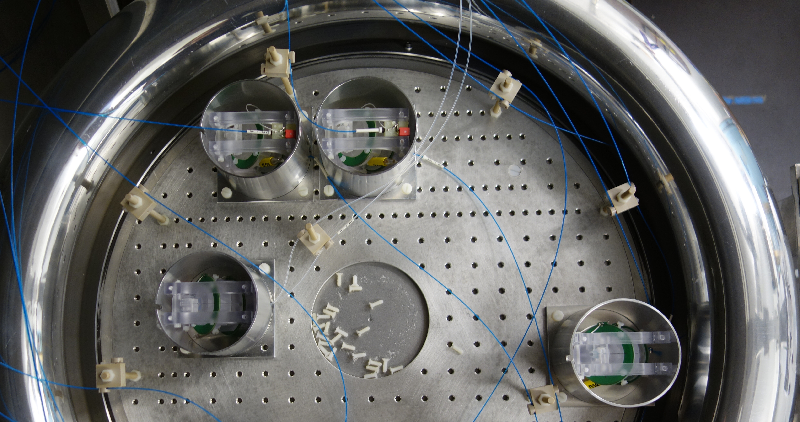New Limit on the Neutron’s Internal Charge Asymmetry
The neutron is electrically neutral, but it might still have an asymmetric internal distribution of charge, a property quantified by the so-called electric dipole moment (EDM). A nonzero neutron EDM is predicted by several theories that seek to extend the standard model of particle physics, and an international collaboration has now placed a new upper limit on how big it could be. To determine the new limit, the team measured the interaction of a cloud of neutrons with electric and magnetic fields. The finding could help theorists narrow the options for explanations of the imbalance between matter and antimatter in the Universe.
For a full understanding of the physical laws of nature, the standard model is not enough—it can’t, for example, reconcile quantum mechanics with general relativity. Researchers believe that a more complete theory is likely to involve breaking of the standard model’s so-called CP (charge-parity) symmetry of the strong force, which binds quarks into baryons (such as neutrons and protons). If such a symmetry violation did indeed occur in the early Universe during the formation of baryons, it would explain why there are many more baryons than antibaryons.
CP violation is predicted to create an asymmetric distribution of quarks inside the neutron, which would result in a nonzero EDM. So a neutron EDM would be a kind of fossil remnant of the symmetry breaking that occurred in the early Universe. And the size of the EDM, if it exists, might offer clues to when the event happened.
Attempts to measure the neutron EDM have been made since the 1950s [1]. More recently, researchers have also looked for the EDM of the electron [2] and of the nuclei of mercury atoms [3]. An attempt to detect a neutron EDM in 2006 [4] by an international team using the neutron source at the Laue-Langevin Institute (ILL) in France found no sign of it within the experimental uncertainty (an improved data analysis was published in 2015 [5]). A new effort led by Philipp Schmidt-Wellenburg of the Paul Scherrer Institute (PSI) in Switzerland and Guillaume Pignol of the Laboratory of Subatomic Physics and Cosmology (LPSC) in France has now searched with more sensitivity than any previous experiment.
A neutron does have a magnetic moment, so it rotates (precesses) in an applied magnetic field. The frequency of precession can be deduced by exciting it to a higher energy state with microwaves. If it has an EDM, an applied electric field should alter this precession frequency, but if not, the electric field would have no effect. Schmidt-Wellenburg and his colleagues looked for such a change in the precession frequency as they held ultracold neutrons from the PSI source in electric and magnetic fields within a cylindrical polystyrene chamber half a meter across. The main innovations of this experiment were in techniques and sensors for detecting variations in the magnetic field, allowing the team to make this field extremely uniform in space and to subtract the effects of the field’s temporal fluctuations from the results.
The well-controlled magnetic field allowed the neutrons to precess in a coherent way for over 30 minutes. The researchers could only collect data for about three minutes because of the rate at which the neutrons were lost by collisions with the chamber’s walls, but that was still 50% longer than in the 2006 experiment [4]. The longer measuring time led to a more sensitive measurement. The researchers placed an upper limit of 1.8×10−26e-cm on the magnitude of the neutron EDM (where e is the charge on the electron), which is almost half the previous best value [4, 5].
Timothy Chupp, an atomic physicist at the University of Michigan, Ann Arbor, who has made previous measurements of the EDM of neutrons and xenon atoms, calls the experiment “beautiful work” that provides “the first new data in two decades.” Molecular physicist David DeMille of Yale University in New Haven points out that the 2016 study of the EDM of the mercury nucleus [3] also estimated a limit on the neutron EDM based on some assumptions, and the result was close to the new one. But he says that the new experiment “is cleaner theoretically and can be interpreted with much greater confidence.”
At this stage, the tighter constraint on the neutron EDM doesn’t rule out any candidate theories, says Schmidt-Wellenburg. But he adds that the result, taken together with those for other particles such as the electron, suggests that strong CP violation may have occurred earlier than the separation of the electromagnetic force from the weak nuclear force in the early Universe.
This research is published in Physical Review Letters.
–Philip Ball
Philip Ball is a freelance science writer in London. His latest book is How Life Works (Picador, 2024).
References
- J. Smith et al., “Experimental Limit to the Electric Dipole Moment of the Neutron,” Phys. Rev. 108, 120 (1957).
- V. Andreev et al., “Improved limit on the electric dipole moment of the electron,” Nature 562, 355 (2018).
- B. Graner et al., “Reduced limit on the permanent electric dipole moment of 199Hg,” Phys. Rev. Lett. 116, 161601 (2016).
- C. A. Baker et al., “Improved experimental limit on the electric dipole moment of the neutron,” Phys. Rev. Lett. 97, 131801 (2006).
- J. M. Pendlebury et al., “Revised experimental upper limit on the electric dipole moment of the neutron,” Phys. Rev. D 92, 092003 (2015).





